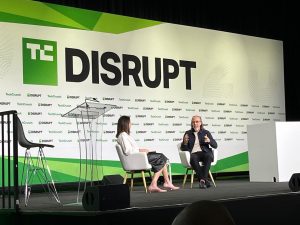 EMERGING TECH
EMERGING TECH
 EMERGING TECH
EMERGING TECH
 EMERGING TECH
EMERGING TECH
From the 17th to the 19th century, tall ships dominated the seas, fostering global trade and exploration. Some corporate leaders today believe that a similar era is underway, only this time the tall ships have been replaced by rocket ships.
Expansion of low-Earth orbit through new generations of satellites, increased demand for space-based communication networks, and the plunging cost of launches have combined to foster a growth industry in space. The influence of launch service provider SpaceX Inc. with its reusable rockets has brought the cost per kilogram of payload down from over $54,000 for the Space Shuttle to $1,400 per kilogram for SpaceX’s Falcon Heavy.
The result has been a tailwind behind space startups and established firms seeking to capitalize on new opportunities created by a renaissance in transportation above the Earth.
“We are in the tall-ships era of space,” said Morgan Beller, general partner at the venture capital firm NFX. “Efficient transportation usually precedes the growth of other markets.”
Beller spoke at the annual gathering of TechCrunch Disrupt in San Francisco on Monday during a series of sessions organized to provide attendees with a better understanding of innovation in space. Easier access to low-Earth orbit has led to a procession of fledging companies seeking to capitalize on space-based innovation.

Aria Alamalhodaei of TechCrunch spoke with Baiju Bhatt, CEO of Aetherflux, about innovation in space during TechCrunch Disrupt.
One such company is Aetherflux Inc., a renewable energy business founded by Baiju Bhatt, former co-founder and co-chief executive of Robinhood Inc. Aetherflux captures the sun’s energy in space and beams it back to Earth ground stations using small satellites and infrared lasers.
Bhatt’s company, which is headquartered in Silicon Valley and emerged from stealth a year ago, raised $50 million in a Series A round this spring that included participation by Bill Gates’ venture firm and Andreessen Horowitz.
“There are a lot of things you can do in orbit that might have had homes on earth,” Bhatt told conference attendees. “People haven’t fully grasped what’s possible there. It’s like putting a gigantic building into space each time.”
An example of Bhatt’s analogy can be seen in the case of Varda Space Industries Inc. The company, which was founded four years ago, uses microgravity in low-Earth orbit to develop unique drug formulations. Pharmaceutical development has moved from the ground into space.
“Being able to turn a knob on a fundamental force, such as gravity, is big for manufacturing,” said William Bruey, co-founder and CEO of Varda Space.
Varda uses SpaceX rockets to launch its capsules holding chemical compounds into orbit. Custom-made lab equipment inside the capsule mix components to form a targeted outcome, taking advantage of microgravity to avoid things such as gas bubbles which could form naturally on Earth.

William Bruey (right), CEO of Varda Space, talked with Aria Alamalhodaei about space tech during TechCrunch Disrupt.
The biggest challenge for Varda has been getting its capsules back on the ground. The pharmaceutical manufacturing process can take one to two months, and Varda is the first company in the U.S. to receive a special license from the Federal Aviation Administration to reenter its capsules without needing to reapply for permission with every flight. Late last month, Varda signed an agreement with spaceport operator Southern Launch that will allow up to 20 reentries of its capsule in Australia through 2028.
“In order for Varda to be successful we need to land on land regularly,” Bruey said. “Reentry is the ultimate arbiter of success.”
Despite the advances made by U.S. firms in commercial space, there is a distinct possibility that China will emerge as the dominant player in the market. A new report, sponsored by the Commercial Space Federation, documented how private capital and government cooperation have allowed China to grow its commercial space sector significantly.
The report noted that annual investment in Chinese commercial space has grown from $164 million in 2016 to $2.86 billion last year. More than a dozen private launch companies with rockets equivalent to SpaceX’s Falcon 9 have raised over $3 billion since 2020.
“This is a highly competitive landscape, we in the U.S. are in a space race with our counterparts in China,” said Aetherflux’s Bhatt. “We have to out-innovate them and out-entrepreneur them. That’s how we stay ahead.”
Companies in the U.S. commercial space industry have been frustrated in recent years by government regulation, yet there have been recent signs this may be changing. The FAA approved a request from SpaceX in May to increase the number of Starship launches from five to 25 per year from its base in Texas. And an executive order was issued by the White House in August to streamline federal review of commercial space launches and establish a new framework governing space missions.
Yet, the U.S. still seems behind the curve in supporting the wave of commercial space activity currently underway, according to Kelly Hennig, chief operating officer at Stoke Space Inc. “The U.S. is not necessarily prepared to see an explosion in launch,” Henning said. “There’s too many restrictions across the board.”

TechCrunch’s Connie Loizos spoke with Alphabet’s Astro Teller about moonshot projects during TechCrunch Disrupt.
Even if the competitive challenge from China can be met or regulation suddenly becomes friendlier, companies in the space industry must also stay ahead of tech innovation here on Earth. The massive network of over 8,000 Starlink satellites currently in-orbit to provide internet access in remote areas of the world has a new competitor thanks to a “moonshot” project from Alphabet’s X Development program.
Taara, spun off earlier this year by X’s parent company, uses ground-based light transmission to beam high-speed internet connectivity. The project emerged from earlier research by Alphabet to establish radiofrequency internet connectivity and laser links using balloons deployed in the Earth’s stratosphere.
In an appearance at the conference by Astro Teller, CEO of Alphabet’s X, the team’s leader described an approach designed to push the boundaries of innovation by exploring ideas that are initially too farfetched to imagine. It’s not unlike the exploratory mindset that landed humans on the moon over five decades ago.
“If you’re proposing a moonshot and it sounds reasonable, we’re not interested,” Teller explained. “I don’t want you to make it work. I want you to get information if this is a once-in-a-lifetime opportunity. For a small amount of money, we can learn something.”
Support our mission to keep content open and free by engaging with theCUBE community. Join theCUBE’s Alumni Trust Network, where technology leaders connect, share intelligence and create opportunities.
Founded by tech visionaries John Furrier and Dave Vellante, SiliconANGLE Media has built a dynamic ecosystem of industry-leading digital media brands that reach 15+ million elite tech professionals. Our new proprietary theCUBE AI Video Cloud is breaking ground in audience interaction, leveraging theCUBEai.com neural network to help technology companies make data-driven decisions and stay at the forefront of industry conversations.